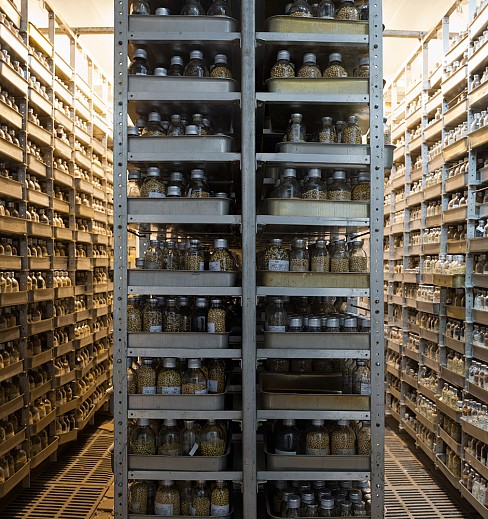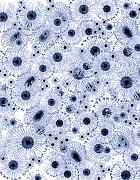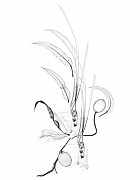


ARTICLE: Dornith Doherty in Antennae #52
October 1, 2020 - Katherine Ryckman Siegwarth
Dornith Doherty: Archiving Eden
A photographic project by artist Dornith Doherty, Archiving Eden considers the scientific, ecological, and philosophical implications of seed banks. The images range from documentary style to lyric compositions, including X-rays of seeds and the use of lenticular panels. Through the interweaving of scientific research, historical references, and poetic aesthetics, Archiving Eden is a transdisciplinary approach that demonstrates how the visual arts can connect seemingly siloed disciplines and prompt contemplative introspection.
Entwined in the narratives of my lifetime is a deep-seated anxiety about the acute gravity of climate change, diminishing biodiversity, and the possibility that we may not be able to retreat from the brink. When I read that a Doomsday Vault—a modern-day ark for plants—had been built near the North Pole, I became determined to photograph it. Two years later, I crossed the threshold into the icy cavern containing a comprehensive catalogue of life. Dornith Doherty [1]
Archiving Eden is a photographic project by artist Dornith Doherty that considers the scientific, ecological, and philosophical implications of seed banks. Since 2008, Doherty has traveled across five continents, visiting eighteen seed banks and research centers to document these locations and their contents. The series is a poignant exploration of global preservation initiatives in the face of decreased biodiversity.
Seed banks vary in size and focus but share a common mission to safeguard genetic material to ensure plant diversity and adaptability, often with an emphasis on food crops. Multiple existential factors impact the survival of life on earth, including climate change, natural disasters, pandemics, and civil strife. Collecting seeds to protect biodiversity is one of the many global conservation initiatives that seek to combat these threats. These collections may save humanity from famine or other disasters and may help scientists understand which genes will improve resiliency for plants in our changing environments.
Planting the Seed
Often discussed in apocalyptic terms by the media, it was a 2007 New Yorker article titled “Sowing for Apocalypse” that introduced Doherty to seed banks and was the source of inspiration for Archiving Eden.[2] The article highlighted Cary Folwer, then-director of Global Crop Diversity Trust, and the construction of the Svalbard Global Seed Vault, which the Trust underwrites (the vault opened in 2008). Located on an island under the sovereignty of Norway, it is situated 50 miles north of the Arctic Circle and anticipated to remain above sea level should the ice caps melt.[3] The vault’s mission is to serve as the back-up supply to seed banks around the world. Its ambition was realized in 2015 when the first withdrawal of seeds occurred due to the Syrian civil war damaging a gene bank near Aleppo.[4]
The necessity of seed banks is made evident by these threats. However, seed banks are sites brimming with hope: even within these cold, archival spaces an Eden may exist, ready to sprout. It is here, in the duality of apocalyptic threats and the optimism of global preservation efforts that Archiving Eden is grounded. The reference to the archetypal garden is itself a dichotomic term, not only referencing paradise but our expulsion from it. The pairing of scientific terminology with lyric symbolism situates the artworks as not only sites of scientific knowledge, but also of philosophical inquiry and historical contextualization, constructing an augmented understanding of the various disciplines. Within seed banks, Doherty sees “a glowing, verdant, technological garden.” [5]
Illuminating Life
Archiving Eden sheds light on seed banks through various aesthetic choices. One section, sub-titled The Vaults, consists of documentary-style photographs of the banks’ exteriors, interiors, and aspects of processing the collections. Seed Vault, Kuban Experimental Station, Russia provides a glimpse into a site generally hidden from public view, whose shelves of seemingly infinite glass containers are filled with abundant, biodiverse resources.
Many images are reminiscent of 19th-century geological survey photographs of the American West, with their matter-of-fact documentation of a new terrain for scientific inquiry. Doherty cites such photographs as influential to her practice, which is rooted in the landscape tradition. Rather than focus on the concept of untouched landscapes of unlimited resources, she examines how environments have been manipulated by human events, extended to even the tiniest seed.[6] Her photographs imagine a terrain of possibility while questioning the limitations of natural resources and the role of humans in their depletion and preservation.
Another section of Archiving Eden is comprised of enlarged X-ray images of seeds and plant tissue. Doherty collaborated with scientists to utilize on-site equipment, customarily employed to determine statistical seed viability of the collection. Later, she edits the images, in some cases flipping the tones, making composite images of multiple seeds and plants. These images maintain scientific detail, but Doherty notes they are openly metaphoric, allowing visitors to reflect between what is shown and the invisible, poetic possibilities of seed banking.[7]
Some photographs, including Banksia, are digitally collaged compositions of X-ray images whose altered colors depict blue specimens on a white background. The array of delicate, circular spindles is reminiscent of the botanical cyanotypes by Anna Atkins, whose British Algae (published 1843–1854) was the first book created entirely from photographs. By illustrating and identifying aqueous organisms, Atkins fused two contemporaneous cultural phenomena, natural sciences and photography, while positioning the new medium as overlapping the arts and sciences, where Doherty’s work is also situated.[8]
The blue and white compositions also allude to Delftware ceramics from the Netherlands. A by-product of trans-Eurasia trade, Delftware was an affordable alternative to Chinese export ware, which was designed exclusively for a European market after the opening of trade routes in the 14th century. Ecological history was also impacted through these same trade routes and cultural exchanges, as human interest and preferences in certain plants led to a relationship in which we have modified their genetic evolution.
Trade and cultural relations are explicit in photographs such as Columbian Exchange III. The title references the global impact—intended and unintended—of Christopher Columbus’ arrival in the Americas in the 15th century.[9] Depicting collaged X-rays of teosinte, eucalyptus, mesquite, and pecan, these plants are indicative of the Texas landscape, Doherty’s home state. However, they are not all native to the region and their co-mingling highlights how humans have altered their environment. The bouquet-like composition of Columbian Exchange III suggests bountiful abundance. Yet, the seeds and tissue samples used for X-ray viability tests are ultimately damaged by the radiation and are unusable specimens. Much like 17th-century Dutch still lifes, these compositions serve as memento mori and highlight the fragility of life.
The melding of science with metaphoric interpretations permeates Doherty’s art, further augmented by using monumental scale and lenticular panels.[10] More than This is an eight-foot-tall lenticular photograph, whose scale elicits an immediate physical response when encountered. Lenticular panels produce a hologram-like effect of movement within the composition, including a color shift as viewers engage with the object. The overall blue and green hues of More than This references cryogenics, a crucial aspect to seed preservation. The color shift performs this transition to keep seeds in suspended animation and vice versa, breathing life back into dormant seeds.
More than This is a composite image of nearly 5,000 individual seed X-rays captured at Kings Park Botanic Gardens, Australia. The number is not arbitrary but symbolic: it is the smallest number required to preserve a single plant species. By visualizing this number, Doherty addresses the issue of psychic numbing, common to conceptual data related to scientific or humanitarian issues.[11] Archiving Eden is an effective entry point for visitors to consider the vastness of global preservation endeavors as the photographs maintain scientific accuracy while scaling down the concepts to an accessible level.
Cultivating Integrative Vision
Through the interweaving of scientific research, historical references, and poetic aesthetics, Archiving Eden is a transdisciplinary approach that demonstrates how the visual arts can connect seemingly siloed disciplines.[12] Doherty’s artworks demonstrate our coevolutionary relationship with plants and the environment, thereby negating the 18th-century concept of humans existing outside of Nature.[13] Unlike scientific disciplines, which often centralize knowledge and rationality outside of a cultural context, Doherty’s artworks present an expansive framework for the seed vaults, connecting the humanities and sciences. The photographs offer contemplative introspection to viewers into fields that may not be a part of their everyday consciousness. Within each suspended, animated seed lies the possibility of metamorphosis and Archiving Eden reveals how something as small as a grain of sand can spark the imagination.
The display of Archiving Eden at the Dayton Art Institute in 2020 demonstrates the continued relevancy of this project. Like many cultural institutions, the DAI shut down in March to assist in global efforts to stem the coronavirus pandemic (the museum reopened in July). At the time of this writing, over one million people have died from the virus, and millions more are affected by the variety of ways the pandemic has affected global trade and infrastructure. Supply-chains were disrupted, causing scarcity of products. This includes food supplies, creating scenarios of unimaginable food waste as producers could not get their products to consumers.[14] The questions of where our food comes from and what actions are being taken to safeguard our future have been brought to the forefront, confirming the integral role of seed banks and the need for innovative projects such as Archiving Eden to shed light on these concerns.
Endnotes
[1] Dornith Doherty, Archiving Eden (Stuttgart: Schilt Publishing, 2017), 9.
[2] John Seabrook, “Sowing for Apocalypse,” The New Yorker. August 20, 2007. https://www.newyorker.com/magazine/2007/08/27/sowing-for-apocalypse
[3] Michael Zimmerman, “High North and High Stakes: The Svalbard Archipelago Could be the Epicenter of Rising Tension in the Artic,” PRISM, 7, no. 4 (2018): 106–123. Cary Fowler, “A ‘Doomsday’ Seed Vault to Protect the World’s Diversity,” Journal of International Affairs, 67, no. 2 (2014): 141–146. Cary Fowler, “The Svalbard Seed Vault and Crop Security,” BioScience, 58, no. 3 (2008): 190–191. Marte Qvenild, “Svalbard Global Seed Vault: A ‘Noah’s Ark’ for the World Seeds,” Development in Practice, 18, no. 1 (2018): 110–116.
[4] Laura Wagner, “Syrian Civil War Prompts First Withdrawal from Doomsday Seed Vault in The Artic,” National Public Radio, September 23, 2015. https://www.npr.org/sections/thetwo-way/2015/09/23/442858657/syrian-civil-war-prompts-first-withdrawal-from-doomsday-seed-vault-in-the-arctic
[5] Elizabeth Avedon, “Trusted Witness.” In Archiving Eden (Stuttgart: Schilt Publishing, 2017), 81.
[6] The Americas were not, of course, pristine, untouched lands at the time of these survey, a concept that omits acknowledgment of Native Americans’ presence and their land management techniques. See Charles C. Mann, 1491: New Revelations of the Americas before Columbus (New York: Knopf, 2005).
[7] Dornith Doherty, email message to author, August 10, 2020.
[8] Hope Saska, “Anna Atkins: Photographs of British Algae,” Bulletin of the Detroit Institute of Arts, 84, no. 1 (2010): 11.
[9] The term “Columbian Exchange” was first coined by Alfred W. Crosby, whose 1972 book, The Columbian Exchange: Biological and Cultural Consequences of 1493 (Westport: Greenwood Pub. Co., 1972) was a novel approach and turning point in the field of geologic history. Doherty notes that Charles C. Mann’s 1493: Uncovering the New World Columbus Created (New York: Knopf, 2011) was influential to her project. For comparison of trans-Eurasia trade and the Columbian Exchange, see Nicole Boivin, Dorian Q. Fuller and Alison Crowther, “Old World globalization and the Columbian exchange: comparison and contrast,” World Archeology, 44, no. 3 (2012): 452–469.
[10] Lenticular panels are multi-angled surfaces that allow the eye to register different portions of a collaged image from various vantage points. Therefore, as you move and engage with the artwork, the angle of perception changes and allows you to see other aspects of the composition, creating the effect of movement within the image.
[11] Paul Slovic, Daniel Västfjäll, Arvid Erlandsson and Robin Gregory, “Iconic photographs and the ebb and flow of empathic response to humanitarian disasters,” Proceedings of the National Academy of Sciences of the United States of America, 114, no. 4 (2017): 640–644.
[12] John C. Ryan, “Cultural Botany: Towards a Model of Transdisciplinary, Embodied and Poetic Research into Plants,” Nature and Culture, 6, no. 2 (2011): 123–148.
[13] P.K. Jamison and Donna Haraway, “No Eden Under Glass: A Discussion with Donna Haraway,” Feminist Teacher, 6, no. 2 (1992): 10–15. Dalia Nassar, “Metamorphic Plants: Goethe’s Metamorphosis of Plants and the Metaphors of Reason,” in Covert Plants: Vegetal Consciousness and Agency in the Anthropocentric World, edited by Prudence Gibson and Baylee Brits (Goleta, CA: Brainstorm Books, 2018), 101–122.
[14] Sarah Gibbens, “These 5 foods show how coronavirus has disrupted supply chains,” National Geographic, May 19, 2020. https://www.nationalgeographic.com/science/2020/05/covid-19-disrupts-complex-food-chains-beef-milk-eggs-produce/
Katherine Ryckman Siegwarth is the Kettering Curator of Photography and Special Projects at the Dayton Art Institute (Dayton, Ohio). She curated the exhibition, Archiving Eden: Dornith Doherty Photographs, on view at the DAI September 13, 2020–January 10, 2021. Prior, Siegwarth was the Assistant Director of Zhulong Gallery (Dallas, TX), and was the Luce Curatorial Fellow for the photography department at the Amon Carter Museum of American Art (Fort Worth, TX). She has held positions at the Scottsdale Museum of Contemporary Art (Scottsdale, AZ) and the Center for Creative Photography (Tucson, AZ). Siegwarth received her MA in Art History, specializing in the history of photography and museum studies, from The University of Arizona (Tucson, AZ).
Dornith Doherty is an American artist whose work is concerned with human entanglement in the rapidly changing environment. A 2012 Guggenheim Foundation Fellow, Doherty has also received grants from the Fulbright Foundation, the Japan Foundation, and the United States Department of the Interior. Working primarily with photography, video, and scientific imaging, Doherty’s work is in numerous permanent collections, and has been featured in exhibitions and publications widely in the US and abroad. A monograph of her project Archiving Eden was published in 2018.
Download Article (PDF)
Back to News
